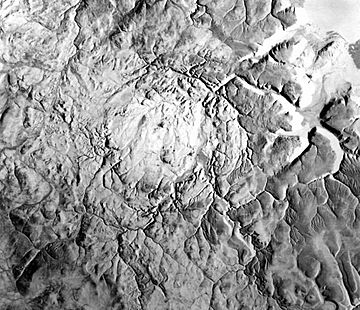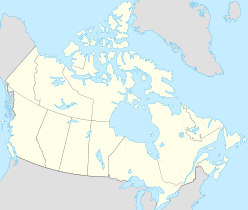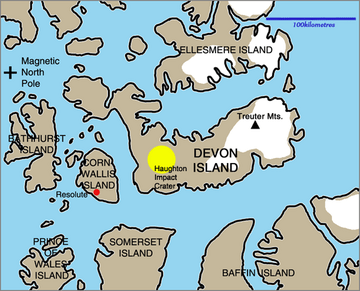Haughton impact crater facts for kids

Synthetic aperture radar image of Haughton crater
|
|
| Impact crater/structure | |
|---|---|
| Confidence | Confirmed |
| Diameter | 23 km (14 mi) |
| Age | 39 Ma Eocene |
| Exposed | Yes |
| Drilled | No |
| Location | |
| Location | Devon Island |
| Coordinates | 75°23′N 89°40′W / 75.383°N 89.667°W |
| Country | Canada |
| State | Nunavut |
The Haughton impact crater is a huge bowl-shaped hole found on Devon Island. This island is in the far northern part of Canada, in a place called Nunavut.
This giant crater is about 23 kilometers (14 miles) wide. It was formed around 39 million years ago. This was during a time in Earth's history called the late Eocene period. Scientists believe a space rock, like an asteroid, hit the Earth to create it. This space rock was probably about 2 kilometers (1.2 miles) across.
Devon Island is made of different types of rock. These include shale and siltstone from the Paleozoic era. Underneath these layers is a harder rock called gneiss. When the space rock hit, it pushed away the top layers of shale and siltstone. This showed the deeper bedrock. Rocks from as deep as 1,700 meters (5,600 feet) have been found here.
What Makes Haughton Crater Special?
The Haughton crater is located very far north, at 75 degrees north latitude. This makes it one of the highest-latitude impact craters ever found.
The weather here is very cold. Temperatures stay below freezing for most of the year. Plants grow very slowly in this harsh environment. Because of the cold and slow plant growth, there is very little weathering. Weathering is when rocks break down due to wind, water, or ice.
This means Haughton crater has kept many of its original features. Craters in warmer places often lose these features due to erosion. Erosion is when rock and soil are worn away.
"Mars on Earth"
Scientists call Haughton crater "Mars on Earth." This is because its geology and climate are very similar to what we find on Mars.
For example, the center of the crater has special rocks called impact breccia. This rock is made of pieces that were thrown out during the impact. Then they fell back into the crater and partly stuck together again. This breccia is filled with permafrost, which is ground that stays frozen all the time.
This frozen rock is very much like what scientists expect to find in craters on cold, wet Mars.
Studying Mars at Haughton
Because Haughton crater is so similar to Mars, it's a great place for scientists to practice. They can test ideas for living and working on Mars right here on Earth.
The Mars Institute and the SETI Institute run a project here. It's called the Haughton–Mars Project. They study the challenges of space exploration.
Another group, the non-profit Mars Society, also works at this site. They operate a research station called the Flashline Mars Arctic Research Station (FMARS). They do similar research to help us learn more about future missions to Mars.



